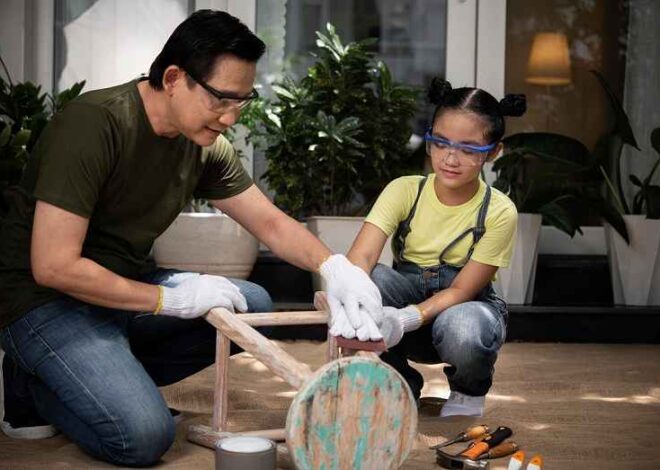
Secure Your Space: Essential Ideas for Safe Home Renovations
Home renovations can be an exhilarating adventure—a chance to breathe new life into your living space, express your style, and increase the value of your home. But while you’re envisioning that stunning kitchen makeover or the cozy reading nook you’ve always wanted, it’s crucial to remember one essential element: safety. Whether you’re a seasoned DIY enthusiast or hiring professionals for the job, ensuring a secure environment is paramount.
Introduction: Why is safety important during home renovations?
Home renovations can be an exciting journey. You’re transforming your living space, enhancing its beauty and functionality. But while you envision the end result, it’s crucial to take a moment and consider safety. Renovating a home is not just about aesthetics; it involves potential hazards that could put you and your loved ones at risk. From structural concerns to hazardous materials, understanding these elements is essential for a successful project.
As you embark on this transformative adventure, keeping safety at the forefront will help ensure that everything goes smoothly. With proper planning and precautions in place, you can create a beautiful environment without compromising on well-being. Let’s explore how to secure your space effectively during your next renovation project!
Assessing potential risks: Identifying hazards in your home and understanding safety measures.
When embarking on home renovations, identifying hazards is crucial. Start by examining your space for structural issues, such as cracks in walls or ceilings. These can signal deeper problems that need addressing before any updates begin.
Consider electrical systems too. Look for frayed wires or outdated outlets that could pose risks during renovation. Make a note of plumbing and gas lines; these are often hidden but essential to check.
Mold and asbestos might lurk in older homes. Hiring professionals to assess these dangers ensures you’re not exposing yourself or workers to harmful materials.
Once you’ve identified potential hazards, research safety measures tailored to each risk. Whether it’s reinforcing beams or upgrading wiring, understanding what needs protection will guide your renovation process more securely. Prioritize safety – it’s the foundation of every successful project.
Planning for safety: Tips on creating a safe renovation plan and working with contractors.
Creating a safe renovation plan is crucial before diving into any project. Start by assessing the scope of work and identifying areas that require attention.
Engage with contractors who prioritize safety. Ask them about their safety protocols and experience with similar renovations. It’s essential they have proper licensing and insurance to protect you from liability.
Develop an open line of communication throughout the process. Discuss timelines, potential risks, and how they will manage hazards on-site.
Incorporate regular safety meetings into your renovation schedule to ensure everyone is aligned on best practices. Documenting these discussions can be beneficial for accountability.
Lastly, always keep emergency contacts handy, including local services such as fire departments or hospitals in case something goes awry during the renovation phase. A proactive approach can make all the difference in achieving a smooth and secure project.
You may also read (home electrical safety)
Protecting your space: Steps to safeguard your belongings and minimize damage during renovations.
Renovations can be exciting, but they often come with the risk of damage to your belongings. Taking proactive steps can make a significant difference.
Start by clearing out the work area. Remove furniture and decor that could get damaged or dirty during construction. If it’s not possible to move everything, consider covering items with sturdy plastic sheeting.
Use drop cloths on floors and other surfaces to catch dust and debris. This simple step protects your flooring from scratches and keeps cleanup manageable.
Designate “no-go” zones for workers as well. Use tape or barriers to keep renovation activities contained in specific areas of your home.
Lastly, make sure valuable items are stored safely away from the work zone. Keeping them in a different room will give you peace of mind while transformations take place around you.
Tools and equipment: Essential safety gear and precautions to take when using power tools.
When tackling home renovations, safety gear is your best friend. Always wear protective eyewear to shield your eyes from dust and debris. A sturdy pair of gloves can protect your hands from sharp edges while providing a better grip.
Hearing protection is crucial too. Power tools can be loud, so consider using earmuffs or earplugs to prevent long-term damage to your hearing.
Don’t forget about respiratory health; a mask will help filter out harmful particles in the air, especially when sanding or cutting materials.
Before you start any project, inspect all power tools for defects. Ensure cords are intact and blades are sharp yet secure.
Lastly, familiarize yourself with each tool’s operation manual. Knowing how to use a tool correctly minimizes risks drastically and maximizes efficiency during renovations.
Best practices for different areas of the house: Safety tips for renovating kitchens, bathrooms, and outdoor spaces.
Kitchens are bustling spaces, making safety paramount during renovations. Ensure that gas lines and electrical connections are handled by professionals. Use proper ventilation to avoid exposure to fumes from paint or adhesives.
Bathrooms often involve wet surfaces, so prioritize slip-resistant flooring. Keep all tools and materials organized to prevent accidents. Install sturdy grab bars near showers and tubs for added security.
Outdoor renovations can introduce unique hazards like uneven ground or power tools around plants and pets. Clearly mark work areas to keep family members at a safe distance. Always wear protective gear when working with heavy equipment or sharp objects.
Consider the weather as well; rainy days can make outdoor projects slippery and dangerous. Prepare your workspace accordingly, ensuring it’s secure before starting any task in these varied environments.
Eco-friendly and safe materials: Choosing non-toxic, low-emission options for a healthier home environment.
When embarking on home renovations, it’s crucial to consider the materials used. Eco-friendly options not only protect the planet but also enhance your living space’s safety.
Look for non-toxic paints and finishes that contain fewer volatile organic compounds (VOCs). These substances can linger in the air long after application, affecting indoor air quality.
Sustainable flooring choices like bamboo or cork are excellent alternatives to traditional hardwoods. They’re durable and contribute to a healthier environment.
For insulation, opt for recycled or natural materials such as sheep’s wool or cellulose. These options provide effective thermal regulation without harmful chemicals.
Remember, even fixtures matter. Choose low-emission appliances designed to minimize environmental impact while ensuring functionality.
By prioritizing eco-friendly materials during renovations, you’re investing in both safety and sustainability for your home.
Emergency preparedness: Creating an emergency plan and being prepared for unexpected situations.
When embarking on home renovations, the unexpected can always occur. Preparation is key to navigating any emergencies that might arise.
Start by developing a clear emergency plan for your household. Identify exit routes and designate a safe meeting point outside your home. Make sure everyone knows how to reach it.
Consider equipping your space with essential emergency supplies. A well-stocked first aid kit, flashlights, and fire extinguishers are must-haves.
Communicate with contractors about safety protocols they have in place. Ensure they understand where emergency exits are located as well.
Lastly, stay informed about local hazards or risks specific to renovation projects in your area. Knowledge is power when facing unforeseen situations during renovations.
Final checks before completion: Double-checking
Before wrapping up your home renovation project, it’s essential to conduct a thorough final check. This is the moment to ensure that all safety measures have been properly implemented and that everything is in order.
Start by inspecting the work done. Look for any visible hazards or unfinished areas. Check electrical outlets, plumbing fixtures, and structural changes to confirm they meet local codes and standards. Ensuring every detail complies with regulations will prevent future issues.
Next, review the areas where you used power tools or heavy equipment. Confirm that all machinery has been stored away safely and that no cords are left exposed on the floor where someone might trip over them.
Don’t forget about ventilation as well; ensure that rooms are adequately aired out after using paints or chemicals during renovations.
Finally, take stock of your belongings one last time before moving back into renovated spaces. Ensure nothing was damaged during construction, especially if you have valuable items nearby.
Taking these steps not only secures your space but also gives peace of mind knowing you’ve prioritized safety throughout your renovation journey while creating a beautiful new area in your home.
You may also read (space heaters and generators safety tips)


